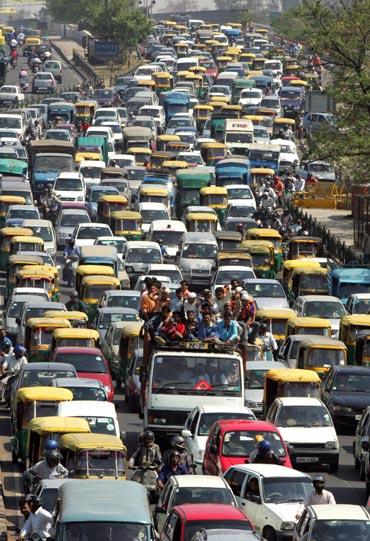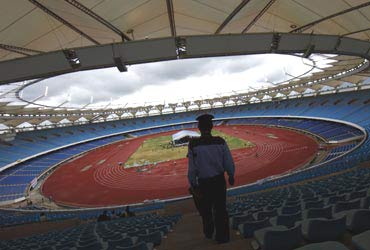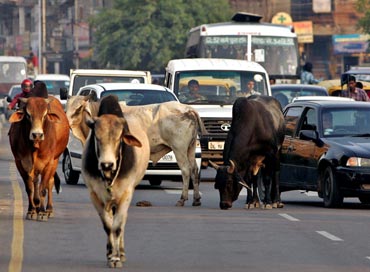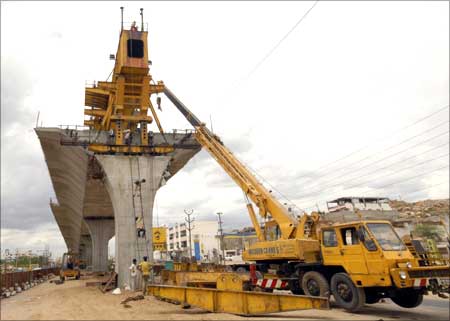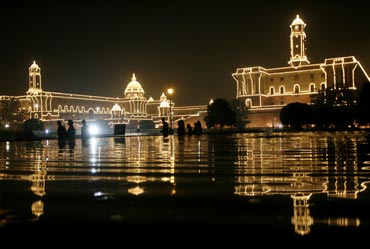 | « Back to article | Print this article |
How to prevent Indian cities from falling apart!
Over the past few weeks the country has been obsessed with whether our spoilt brat of a city, Delhi, will perform well in front of a global audience.
Now that it has, with all and sundry observing traffic regulations and not making a nuisance of themselves, there is general elation.
In the end, disaster was averted. The whole situation was managed like an Indian wedding with the parents throwing vast sums of money at all problems and a bunch of siblings pitching in at the last minute to make up for the main organiser's incompetence.
The fears of the weeks before the Commonwealth Games (CWG) have given over to an orgy of self-congratulations.
The pessimism and the doubts before, and the euphoria after, are part of our national character, reflected quite accurately by our media, which suffers from what some would describe as a bipolar or manic depressive disorder -- unjustified pessimism and equally unjustified self-satisfaction alternating wildly.
Click NEXT to read on . . .
How to prevent Indian cities from falling apart!
But if you thought the CWG was badly managed, wait till you see the scale of the urban management effort that confronts us in the decades ahead.
What had to be done for the CWG in Delhi is small compared to what will be required to prevent urban India from falling apart over the next few decades.
According to the UN population projections, the absolute size of the rural population will start declining by 2025-30 and by 2050, it will be 125 million less than now.
Urban population will grow continuously and be 525 million larger in 2050. The numbers would look even larger if we were to include many peri-urban villages that the census persists in classifying as rural.
Some 200 million people or so will have to shift from their traditional family occupations. An occupational shift of this order will imply a massive change in the urban-rural distribution and the pace of urbanisation may be even more rapid than the trend projections, particularly in the northern states of Uttar Pradesh, Bihar, Rajasthan, Madhya Pradesh and Jharkhand.
Click NEXT to read on . . .
How to prevent Indian cities from falling apart!
The scale of effort required to cope with the projected growth in urban population is mind-boggling.
Take for instance the provision of mass transit. Delhi is planning nearly 400 km of metro and bus rapid transit corridors. The McKinsey projection* for the country as a whole calls for 7,400 km by 2030 -- a bit like putting up the equivalent of a Delhi Metro per year!
Or take water supply; we will need several plants the equivalent of Sonia Vihar every year.
As for housing and commercial space, forget the Games Village. The McKinsey report calls for a scale of construction that would be like putting up a Chicago from scratch every year.
The report also estimates the investment requirement to be $1.2 trillion over the next two decades, or about $60 billion per year or ten times what we spent on the CWG.
Click NEXT to read on . . .
How to prevent Indian cities from falling apart!
The key challenges are the functioning of urban land markets, the financing of massive infrastructure investments and the reform of municipal governance. We do not have adequate answers in any one of these three areas of concern.
When it comes to urban land markets, our only answer is large-scale public ownership of land and drastic controls on the operation of private land markets.
This poorly functioning land market and inadequate or poorly conceived public interventions in this market, push the poor into slums. Developers are pushed to an urban fringe, like Gurgaon or the distant suburbs in the north and east of Mumbai, leading to an urban sprawl that taxes the infrastructure to breaking point.
All big cities have been developed because large tracts of land were assembled for development by private or public entities. Transport and infrastructure investments directed rather than followed land development.
We need a system where the public authorities mobilise resources for urban infrastructure directly or through partnerships with the private sector and lead the evolution of the city through actual investments rather than through master plans.
Click NEXT to read on . . .
How to prevent Indian cities from falling apart!
The private sector part of urban development needs a land market system that operates transparently to allow land aggregation for large-scale housing and commercial development. One approach is to use land adjustment schemes that aggregate a large tract of land, with the developer using some part and returning the rest in agreed proportion to the original owners, who can then cash the capital gains in any way they wish.
This was tried recently in Ahmedabad and it worked. Better land records would also help towards this end.
A transparent urban land market can also help unlock the values trapped in public holdings of land and help address the second big bottleneck which is municipal finance.
The Thirteenth Finance Commission has made a beginning in this area; but much more fiscal decentralisation is needed to allow this third tier of governance to function effectively.
One way of tapping resources is to unlock the value trapped in the large land holdings of public authorities like the railways, India Post, the defence department, port trusts and urban development authorities like DDA and MMRDA that were vested with acquired land.
Click NEXT to read on . . .
How to prevent Indian cities from falling apart!
None of this will happen unless we have effective leadership. Directly elected mayors could provide the political entrepreneurship that our cities and towns need so badly. But they must be fully empowered and the spectacle we saw in Delhi where the chief minister and the lieutenant governor were jockeying for leadership and visibility must be avoided.
More than that, municipal governments must exercise full territorial authority and be in charge not just of municipal and social services but also transport and land use in the urban fringe and law and order.
One more big change is needed. We are wedded to a philosophy of town planning that places great faith in master plans and bureaucratic controls to implement it. In reality, this leads not to better planned cities but to more corrupt and criminalised municipalities and urban authorities.
In place after place, people are making their own cities, often in unauthorised colonies, while planners cater to a small elite. Planners must learn to work with these entrepreneurial city dwellers to improve water, drainage, health, safety and housing quality.
Urban planning and architecture must move out of their engineering origins and become social science disciplines, working with the ebb and flow of social forces.
*India's urban awakening: Building inclusive cities, sustaining economic growth, McKinsey Global Institute, April 2010.
